When you think of Tulum, you probably imagine a down-to-earth hippy-dippy beach town with pillowy white sand beaches, turquoise blue waters, ancient Mayan history, and… influencers everywhere you look.
What once was a dreamy haven for off-the-beaten-path travelers has now turned into hoards of tourists just visiting to take those “classic” Tulum shots. You know, the ones with the inspirational signs, picture-perfect acai bowls, and larger-than-life art installations?
So is Tulum still worth visiting? Let’s talk about it.
What was Tulum like before?
Before the rise of Instagram as we know it, Tulum was a sleepy little beach town on the Mexican coast, only known to a select few travelers who managed to make it “off the beaten path” in the Quintana Roo state of Mexico. The town was inhabited mostly by locals, with a few ex-pats scattered here and there. Life was quiet and peaceful.
Sometime during the mid-late 2000s, celebrities discovered the idyllic sandy beaches and hippy vibe the town gave off, and before you knew it, Tulum was blown out of the water. Shortly after the arrival of Kardashian-level celebs came the Instagram influencers of all niches, lining up to get the perfect photo.
What is Tulum like today?
We all know you’re thinking it, and I’m just going to be honest about it. Tulum has been put on the map by its countless Instagram-worthy photo locations. This town has everything from Pablo Escobar’s mansion, smoothie bowl cafes, perfect beach bar swings, and cenotes. Many American and Canadian digital nomads have moved here, set up shop, and are prepared to ride out the incoming tourist boom.
As I was traveling Quintana Roo in search of a budget-friendly authentic Mexican experience and have almost only been exposed to the overcharged, overcrowded touristy side of Mexico. With the influx of tourists came a boom in business and the economy, driving prices sky-high, almost on par with some major cities in the USA.
Drinks and dinner at a nice restaurant can cost you upwards of 30-40 USD per person, depending on where you go, and most hotels run from 40-350 USD per night.
Deep Dive
Despite being over-run with influencers of all sorts, it’s not to say Tulum should be skipped because whether you are coming for the gram, to relax, or on a budget, there still is a thriving cultural heart inside this famous town that’s waiting to be discovered.
Tulum, The Instagram Side:
I visited a few of the free-ish Instagrammable highlights of Tulum, including:
- The Tulum Sign
- Expensive restaurants
- Matcha Mama (the town location)
- Tulum beach
- The Tulum Ruins
- Grand Cenote
I also did the cliche things like:
- Rent fixie bikes (for the aesthetic and the price)
- Take pictures with VW bugs
- Take photos in my picture-perfect hotel
Instagrammers “Tulum must-do list” things I missed:
- Follow that dream sign
- Casa Malca
- Azulik hotel
- Coco Tulum
- Beach location Matcha mama
As I was checking out these places, I couldn’t help but wonder how this affects the locals and their livelihood. Do they enjoy hoards of selfie stick-toting tourists? Do they enjoy walking by restaurants that they can’t afford (restaurants I could barely afford)?
One aspect to consider is the environmental aspect of the tourism industry in Tulum. With tourists come dirtier beaches, overrun and dirty streets, ecological destruction, misuse of historical sites, and a potentially contaminated freshwater supply. Tulum has a beautiful and fragile ecosystem all around it, and we must take care of it when visiting.
I noticed that many businesses are owned by non-Mexican people, and I wondered how this contributes to the economy. Is it hindering or helping?
The homes and businesses in Tulum are becoming increasingly unaffordable for locals, causing them to be pushed further and further out of Tulum town, making the amenities and businesses there inaccessible.
All these facts and realities I saw in Tulum left me feeling torn and conflicted about Tulum and the tourist industry. On the one hand, it provides a livelihood for the people in Tulum, and on the other, it’s destroying the town and its authenticity.
Tulum, The The Authentic Side:
Scattered through my visit to Tulum, I was also able to discover some local hot spots and experience such things as:
We found a small pop-up taco restaurant called Taqueria Honorio and saw many locals and foreigners enjoying a delicious meal there.
I was delighted to stumble upon a random dance number in the town square and a 12-person improv orchestra playing at a local Mojito bar. I enjoyed renting bikes and taking them for a spin down the highway to get to a lesser-known cenote for a swim (although this one is becoming overrun as well).
Is it worth it?
So my conclusion? Yes, Tulum has wholly lost its authentic hippy, sleepy beach town vibe and has become a hot spot for all-inclusive resorts, club-goers, and influencers.
The truth about Tulum is that there seem to be more Instagrammers and ex-pats than locals. Everywhere you turn, there’s a photo opportunity, and businesses will add a tip to your bill just because you are foreign (this is illegal) and things are a bit expensive. Nomadic Matt said it best when he called Tulum “Utterly Terrible.”
But does that mean it should be avoided altogether? No.
Amongst the picture-perfect locations, art installations, and flowy dresses, there is still an authentic underbelly to Tulum that is worth exploring. You just have to work for it a little bit.

